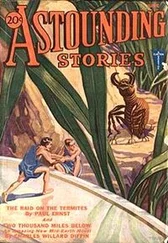It is also your responsibility to provide for the human needs of the astronauts. In the objective scientific stance so characteristic of the twentieth and twenty-first centuries, sexual needs are viewed as but one of the many human needs which must be provided for within the cramped confines of the spaceship, e.g., need for food, water, oxygen, exercise, simulated gravity, and so on. Previous missions have shown that pornography, Penthouse magazine, tapes of Nancy Friday, inflatable female dolls, and masturbation have been unsatisfactory sexual outlets. Nor have inhibitory hormones, saltpeter, cold baths worked.
You conclude that human sexual needs require humans to satisfy them.
It was decided against sending a husband and wife, not merely for the reason that a husband-and-wife team was not available, but because of evidence adduced by staff social scientists that the institution of marriage had fallen on such evil days that four out of five married couples studied — as well as unmarried live-in couples — were already so sick of each other that no one would take responsibility for what they might do to each other after years in space.
Accordingly, you have five crews available from whom you must choose one.
(1) A pair of good-humored and well-qualified astronauts, a man and a woman, who have no religious scruples and no marital or emotional attachments, a Burt Reynolds and a Shirley MacLaine type, each highly skilled technically, each sexually experienced and happily and actively and somewhat casually heterosexual, and who, though not well known to each other, find each other attractive — but who, let us admit it, are a little dumb and know next to nothing of Western civilization, literature, or history, beyond last year’s winner of the Super Bowl and the comparative ratings of Snyder, Carson, and Letterman during the last ratings sweeps.
(2) A pair of lesbians, an inseparable couple, pleasant, fastidious, housekeeping, “married” middle-aged homebodies with a low sex drive and a high toleration for closeness and intimacy. Besides being excellent astronauts, both are highly cultivated. One is by avocation a historian, the other a poet.
(3) A pair of male homosexuals from San Francisco. Strangers to each other before training, promiscuous as chimpanzees, they find each other attractive. Outside their technical proficiency, they have a range of interests; one was active in San Francisco politics, the other a Rhodes Scholar in medieval studies.
(4) A lapsed Catholic, Irish, Midwestern male chauvinist, and a militantly feminist woman. Despite, or perhaps because of, their differences, they get along famously. The male is perhaps the best qualified technically of the lot, his marriage is on the rocks, and he is highly sexed, humorous, and salacious as only a Christian or ex-Christian can be (as horny as a preacher, as the saying goes). The female is a handsome Gloria Steinem-Radcliffe type who subscribes to the NASA view that sexual drives and needs are normal biological properties of the human organism, and is willing to satisfy hers and his on the basis of an equality between the sexes — i.e., it must be understood that she is as free as he to initiate sexual behavior. (Her insistence on this point at the first interview made the male astronaut’s eyes sparkle with anticipation.)
These two were technically the best qualified of the crews, but one thing troubled the NASA project manager. In the standard questionnaire, the male astronaut responded to questions 45, 46, and 47 in the following fashion:
Q.: Do you now or have you ever professed a religion?
A.: Yes. But not now.
Q.: What was it?
A.: Catholic.
Q.: Do you regard sexual intercourse outside marriage as sinful?
A.: Technically, at the most. But in the interests of God and country I will make the sacrifice.
What bothered NASA was not that he might be compromising his principles — indeed, he seemed gleeful at the prospect — but rather a certain irony and flippancy in his answer. Beware of smart-ass ironical types, warned one of the older astronauts, the last of the line of un-ironical men beginning with John Glenn and Neal Armstrong. The NASA psychologist noted that the irony might conceal a deeply rooted scruple which might surface later in the mission. One thing the mission didn’t need was a guilty astronaut. Imagine an adulterous and penitent Catholic looking for a priest and a confessional on PC3 like a character in a Graham Greene novel.
(5) Two Nobel Laureates, both male and past middle age, who, though just barely competent as astronauts, expressed a willingness in the interests of humanity to masturbate regularly during the ten years of a mission, saving and freezing the ejaculate for the insemination of millions of suitable if intellectually inferior women toward the end of upgrading the human gene pool.
Which crew would you choose? State your reasons.
CHECK ONE)
A Space Odyssey (II). (20) The Self Marooned in the Cosmos: What do you do if there is no man Friday out there and we really are alone?
A STARSHIP IS RETURNING to earth after a voyage of eighteen years. *
It set out with hope and excitement and good reason to expect success.
After many years of fruitless monitoring of radio emissions from space, the spectrum analyzer at SETI picked up a patterned transmission in the 1400-megahertz range which could not, apparently, be accounted for by the random noise of the Cosmos. The source was the region of Barnard’s Star some six light-years distant. There were bursts of energy with a lesser radiation in between. The configuration was repeated over and over again. Some of the clusters could be countered as prime numbers. Very possibly it was a message in a nested code: a kind of palimpsest consisting of an overlay of prime numbers (but somewhat garbled) to make contact, and under it a primer to establish a language, and under that, the message.
Hopes were raised further by an analysis of a perturbation of Barnard’s Star suggesting an orbiting planet, perhaps two, and now confirmed with such a high degree of accuracy that only two planets approximately the size of the earth could cause it.
But the message, if it was a message, could not be decoded. No doubt it was garbled by some intervening source of radiation.
Finally, it was decided at NASA to send a manned vehicle, the Bussard interstellar ramjet, which accelerates to velocities approaching the speed of light by means of a frontal scoop that funnels hydrogen atoms into a fusion engine and ejects them through a rear jet.
Some extraordinary considerations went into the planning. One was the generally accepted, though not yet proved, consequence of Einstein’s general theory, namely that — and here the mind boggled — though the voyagers on the starship would experience time as a lapse of eighteen years and would be eighteen years older when they returned, between 400 and 500 years would have elapsed on earth upon the return of the starship — depending on how close to the speed of light the Bussard ramjet could drive the ship.
The human problems were unprecedented. Friends and family of the crew, and fellow scientists, would be as long dead to them as Galileo and Columbus are to us. A crew must be found who shared the following unusual characteristics: they must be willing and able to live together in close quarters for eighteen years; they must be willing to leave behind family, husbands, wives, forever; they must be prepared to return to an earth which would either be destroyed or so technologically advanced that their homecoming in the ancient ramjet would be something like Rip Van Winkle riding a mule into the Jet Propulsion Lab in Pasadena. Finally, in the event of the former, they must reproduce themselves.
The first problem was approached by calling for volunteers who for their own good and sufficient reasons were willing to leave — perhaps, as in at least one case, for patriotic reasons: somebody has to do it, we’re in trouble, and maybe the civilization on Barnard P1 can help us. Or for less admirable though just as compelling reasons: wanting out, bad marriages, wanderlust in the old U.S. head-for-the-territory, walk-out-the-front-door-and-hit-the-road tradition, or just being sick and tired of the old earth with its sad past and sadder prospects for the future, sick and tired of living in the gloomy condos of Houston, Pasadena, and Canaveral. Whatever. Volunteers were not hard to come by. NASA was deluged by thousands of applicants, not merely nuts, but qualified scientists. Apparently, many people wanted out. The main problem was not the choice of individual crew members but rather the social composition of the crew. After a careful review of cultural trends, such as the breakdown of monogamous marriage and the newest experiences in communal living, open marriage, serial monogamy, polygamy, and in the light of recent discoveries of genetic differences in the right and left-brain cortices of men and women, a crew of four was hit upon. One man and three women. Consultation with the best American neurologists and behaviorist psychologists and group-psychotherapists and with the most highly regarded Moslem sociologists and neo-Mormon marriage counselors confirmed the decision. The projected life style was to be called “programmed serial monogamy.”
Читать дальше












